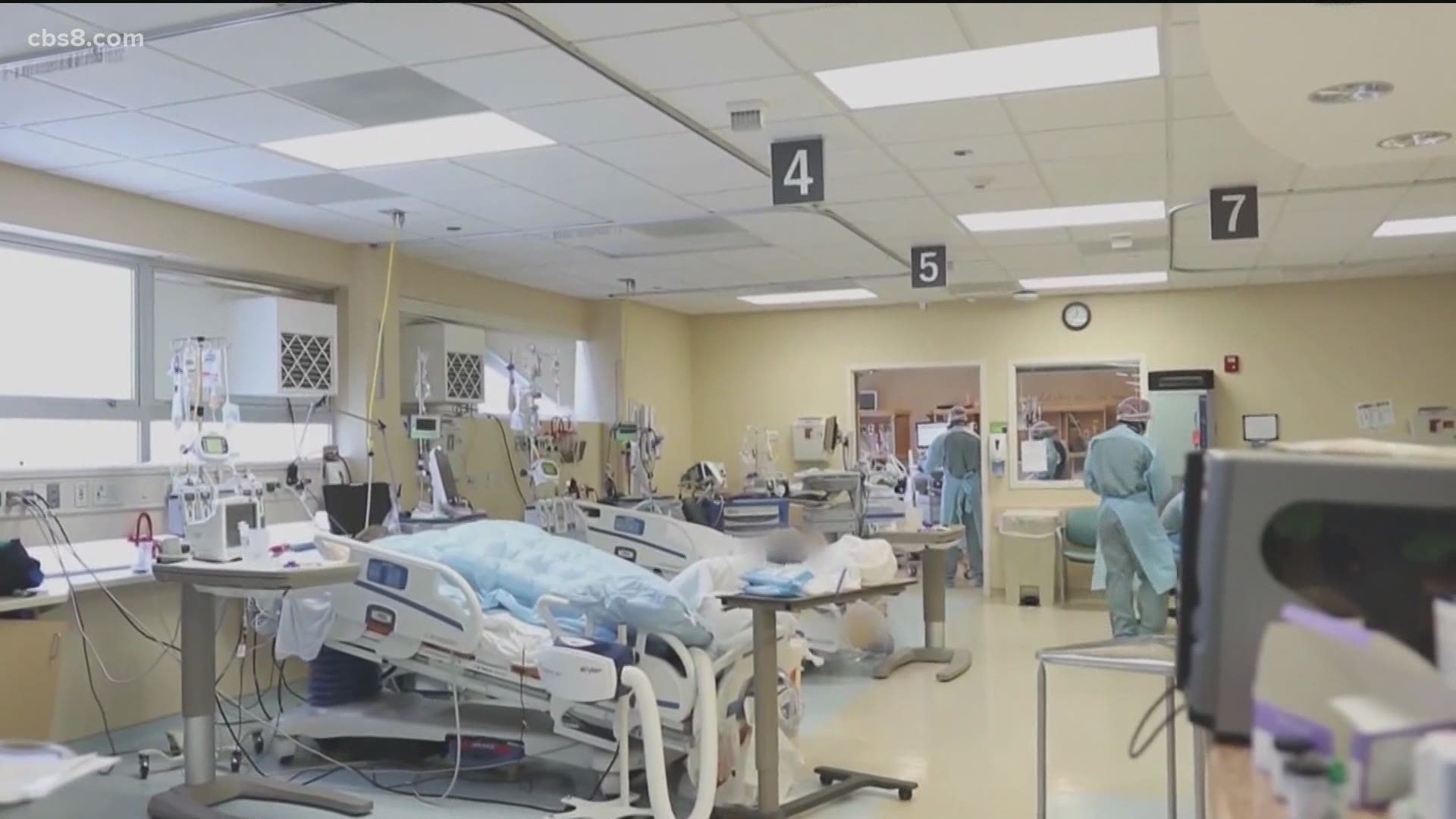SAN DIEGO — San Diego County hospitals have prepared in anticipation of a large increase in patients with COVID-19. The county added nearly 25,000 new cases in the first 29 days of November, compared to 9,617 in October. The California Department of Public Health projects about 12 percent of cases will end up in the hospital.
“We're planning for every possible contingency, making sure that we're ready to go,” said Omar Khawaja, MD, Chief Medical Officer for Palomar Health.
San Diego County health officials reported 959 new COVID-19 infections Monday amid a surge in hospitalizations that have nearly tripled in a month's time.
The San Diego County Health and Human Services Agency reported that 692 coronavirus patients were hospitalized as of Monday, with 180 of them being treated in intensive care units
On Monday, Palomar Medical Center was treating more than 60 patients with COVID-19, a 50 percent increase over its last record that was set during the initial surge in April and May.
Countywide, more people are in the hospital with COVID-19 than at any point during the pandemic. The number of patients has tripled since Oct. 1 amid a steep increase in cases. So far, hospitals have managed the surge and have the capacity to handle more cases.
“We have that ability to flex. It's allowing us to use all of our capacity. So, we still have about 25% of our capacity available,” said Khawaja.
San Diego County reserves 20% of regular hospital beds and intensive care unit space available for coronavirus patients. The state has also identified 11 sites that can be used to assist with additional space. However, it cannot as easily replicate ICUs. CDPH estimates project, without intervention, Southern California could exceed ICU capacity by late December.
“Statewide, we see the second half of December could push the limit in some areas. We have to act sooner to get transmission down and handle high ICU surges,” said Gov. Gavin Newsom, who hinted additional restrictions could be coming soon for counties in the purple tier, like San Diego.
Hospitals also have some flexibility to free up ICU space. In April, during the first wave of cases, hospitals anticipated being overwhelmed and delayed some less urgent surgeries and care. Available ICU space peaked on April 26 at 61%. It was eventually reduced once it was determined other procedures could continue.
This time, hospitals may wait to delay care because a delay in planned procedures will have an immediate effect on ICU capacity.
“At 80% ICU capacity, we start talking about scaling back things like surgery, starting to limit procedures and interventions that are emergent or urgent,” explained Khawaja. “We're not at that point yet, but there are definite triggers in place that as each level of capacity gets used up, we have things that we would do to open up more capacity.”
Some public health officials believe this surge may not be as deadly as previous increases. Doctors have become more familiar with COVID-19 and have more treatment options at their disposal, such as Remdesivir and steroid options.
“Those are those are good medications that are having an impact,” said Khawaja. “We're also just understanding the disease better. Early on, we thought we intubate quickly, get them to the ICU and don't get them off that [ventilator] for as long as you can. That thinking has changed a little bit where we actually try and keep them off the ventilators for as long as we can. Now we believe that may be helping.
“Also, there is something different about the disease that we're currently seeing. The number in the ICU and the acuity has not been as high, but I do just want to caution, that being said, it is still a deadly disease. We are still seeing an 11% mortality rate in our facility. So, that is a very concerning thing.”
While treating the patients, hospitals have begun preparing to distribute an eventual vaccine. Newsom estimated California will receive 327,000 doses by mid-December. The vaccine requires a second dose that will arrive within the following three weeks.
State and federal health officials are still working on distribution plans. Healthcare workers and others who work directly with COVID-19 patients, followed by at-risk congregate living residents are expected to be among the first to receive the vaccine.
However, Pfizer’s vaccine requires storage in ultra-cold freezers because it must be kept at -94°F. Most other vaccines require temperatures between 36°F-46°F. Typically, only research institutions have ultra-cold storage.
San Diego County has worked to procure some ultra-cold freezers for hospitals and worked with Rady Children’s Hospital to create a central storage site, since it already has ultra-cold freezers.
Palomar Hospital does not currently have an ultra-cold freezer, but will soon receive one from the county and is purchasing a second.
“We expect those both to be here in plenty of time to be able to have the vaccine,” said Khawaja. “The health systems are working together. The county is in lockstep with us. I think one of the really positive things that's come out of COVID is just the amount of collaboration and communication that we've built among the different health care providers in San Diego County.”

